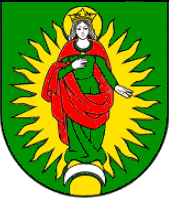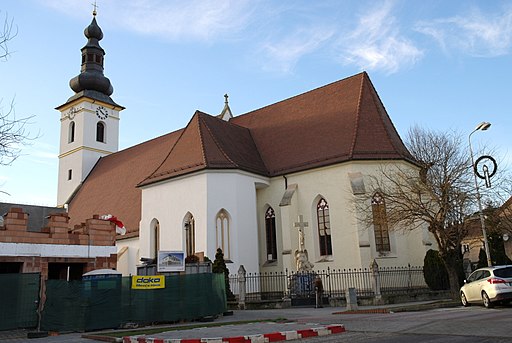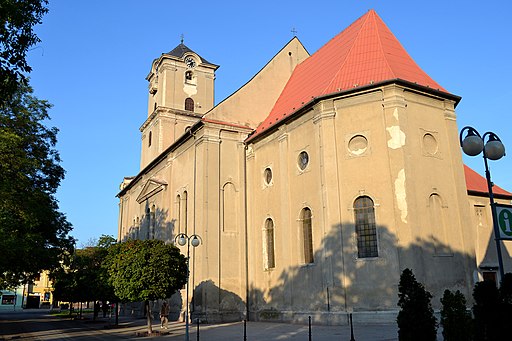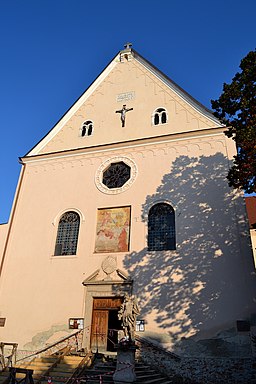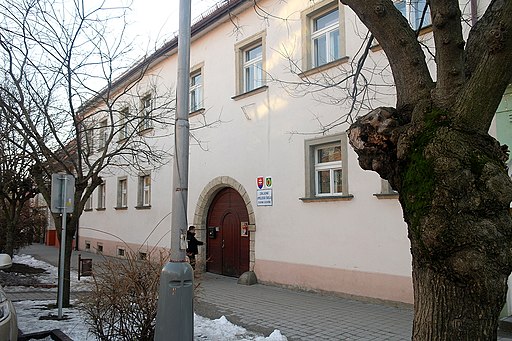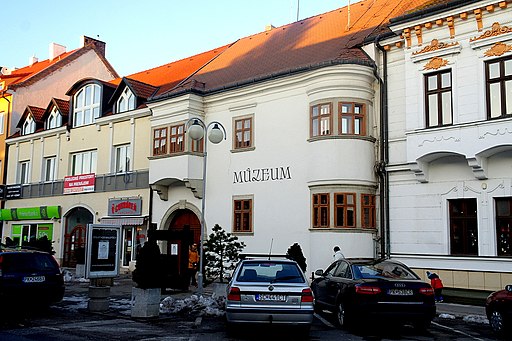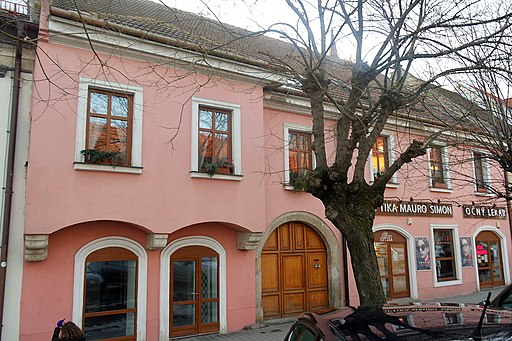Bazin
Historical Hungarian county:
Pozsony
District:
Bratislavský kraj
GPS coordinates:
48.286377, 17.269857
Population
Population in 1910
| Total |
4809 |
| Hungarian |
11.96% |
| German |
32.4% |
| Slovak |
54.95% |
The small town at the foot of the Little Carpathians was originally a mining settlement. Later in the 16th century German settlers arrived and they made it a major wine-producing region. It quickly became rich due to its excellent wines and it was granted the status of a free royal town. Its castle was built by the Bazini and Szentgyörgyi family in the 13th century. It was turned into a Renaissance castle by the Illésházy family at the beginning of the 17th century, and Pálffy János, a member of the extremely wealthy Hungarian aristocratic family, renovated it at the beginning of the 20th century.
Check out other towns in Upper Hungary (Slovakia) as well!
895
Arrival of the Hungarians
Little more...
895
The alliance of the seven Hungarian tribes took possession of the then largely uninhabited Carpathian Basin. Until then, the sparse Slavic population of the north-western Carpathians had lived under Moravian rule for a few decades after the collapse of the Avar Khaganate in the early 9th century.
1000
Foundation of the Hungarian Kingdom
Little more...
1000
The Kingdom of Hungary was established with the coronation of King Stephen I. He converted the Hungarians to Christianity and created two archdioceses (Esztergom and Kalocsa) and ten dioceses. He divided Hungary into counties led by ispáns, who were appointed by the king.
1208
It was mentioned for the first time as terra Bozin. It was originally a mining settlement. King Andrew II of Hungary gifted the area to Tamás of the Hontpázmány clan who was the Ispán of Nyitra County. He was the ancestor of the Szentgyörgyi noble family.
1241-1242
Mongol Invasion
Little more...
1241-1242
The hordes of the Mongol Empire invaded Hungary and almost completely destroyed it. One third to one half of the population was destroyed. The Mongols also suffered heavy losses in the battle of Muhi and they could not hunt down the king. After their withdrawal, King Béla IV reorganized Hungary. He allowed the feudal lords to build stone castles because they were able to successfully resist the nomadic Mongols. The vast majority of stone castles were built after this. The king called in German, Vlach (Romanian) and Slavic settlers to replace the destroyed population.
April 1271
King Ottokar II of Bohemia occupied Bazin along with other castles and towns of northwest Hungary. He wanted to establish his own empire.
July 2, 1271
After the defeat of the army of Ottokar at Mosony, according to the peace the occupied territories were regained by the king of Hungary.
13th century
The Szentgyörgyi family built a castle.
1301
The extinction of the House of Árpád
Little more...
1301
The House of Árpád, the first Hungarian royal dynasty, died out with the death of King Andrew III. Hungary was ruled by oligarchs, the most powerful of whom was Csák Máté, whose main ally was the Aba family. King Charles I (1308-1342), supported by the Pope, eventually emerged as the most prominent of the contenders for the Hungarian throne. But it took decades to break the power of the oligarchs.
early 14th century
The Szentgyörgyi family supported King Charles I against the oligarch Csák Máté, who did not occupy Bazin.
1386
During the game of thrones after the death of King Louis I of Hungary (Louis the Great), queen Mary, the wife of Sigismund (later Holy Roman Emperor), pawned Pozsony County to the Moravian marquess Jodok and Prokop to gain their support.
1389
Sigismund paid the debt. Unlike Jodok, Prokop was unwilling to return the properties to Sigismund, so the Hungarian king had to retake many castles of Pozsony County by siege.
1459
Bazini and Szentgyörgyi György, János and Zsigmond counts together with other barons elected the Habsburg Frederik III, Holy Roman Emperor, to the throne of Hungary against Matthias Corvinus.
1464
The lords of Bazin swore loyalty to King Matthias.
1514
With the death of Judge Royal Bazini and Szentgyörgyi Péter the family became extinct. Bazin fell to the hands of Szapolyai János.
1526
Battle of Mohács and the splitting of Hungary into two parts
Little more...
1526
Sultan Suleiman I launched a war against Vienna, instigated by the French. Ferdinand I, Duke of Austria, was the brother-in-law of King Louis II of Hungary. The army of the Ottoman Empire defeated the much smaller Hungarian army at Mohács, and King Louis II died in the battle. A group of the barons elected Ferdinand I of the House of Habsburg to the throne, who promised to defend Hungary from the Turks. He was the younger brother of the most powerful European monarch Emperor Charles V. But the nobility chose the most powerful Hungarian baron, Szapolyai János, who was also crowned as King John I. The country was split in two and a decades-long struggle for power began.
1527
King Ferdinánd occupied the town from Szapolyai János.
1541
The Turkish occupation of the capital, Buda, and the division of Hungary into three parts
Little more...
1541
The Turks conquered Buda, the capital of Hungary, after the death of King John I. The central part of the country was under Turkish rule for 150 years. The western and northern parts (including present-day Slovakia) formed the Kingdom of Hungary ruled by the Habsburg emperors. The eastern parts (now mainly under Romanian rule) were ruled by the successors of King John I of Hungary. In 1571, John II (John Sigismund), the son of King John I of Hungary, renounced the title of King of Hungary in favor of King Maximilian of the House of Habsburg, and henceforth held the title of Prince. This formally created the Principality of Transylvania, which was the eastern half of Hungary not ruled by the Habsburgs and was also a vassal of the Ottoman Empire. John II died in 1571, after which the three nations of Transylvania (the Hungarian nobility, the Székelys and the Saxons) elected the prince.
16th century
Germans settled down in the town. It became an important vine producing area.
1580
Bazin was pawned to Illésházy István.
1601-1603
There was a trial against the Protestant Illésházy István based on forged charges of treason. He was sentenced to death and his properties were confiscated. He fled to Poland.
1604-1606
Uprising of Bocskai István
Little more...
1604-1606
The alliance of the Habsburgs and the Principality of Transylvania was defeated by the Ottoman Empire in the Fifteen Years' War. The war devastated Transylvania, which was occupied by the Habsburg imperial army, and General Basta introduced a reign of terror. The nobility and the burghers were upset about the terror, the plundering mercenaries and the violent Counter-Reformation. Bocskai István decided to lead their uprising after the Habsburg emperor tried to confiscate his estates. Bocskai also rallied the hajdú warriors to his side. He was elected Prince of Transylvania and soon liberated the Kingdom of Hungary from the Habsburgs. In 1605 Bocskai István was crowned King of Hungary with the crown he received from the Turks.
1605
Prince Bocskai István of Transylvania occupied Likava and gave it back to Illésházy István.
23 June 1606
Peace of Vienna
Little more...
23 June 1606
Bocski István made peace with Emperor Rudolf. Their agreement secured the constitutional rights of the Estates of Hungary, and the freedom of religion. The counties of Szatmár, Bereg and Ugocsa were annexed to the Principality of Transylvania. Bocskai died of illness in the same year, leaving to his successors the idea of unifying Hungary from Transylvania.
September 24, 1606
In the Peace of Vienna that ended the Bocskai-uprising the insurgents received mercy and Illésházy recovered his properties.
1608
The castle was reconstructed in Renaissance style by the Ilésházy family.
1619
The campaign of Prince Bethlen Gábor of Transylvania in the Thirty Years' War
Little more...
1619
At the beginning of the Thirty Years' War (1618-1648), Prince Bethlen Gábor of Transylvania went to war against the Habsburg emperor as an ally of the rebelling Czech-Moravian-Austrian estates. The whole Kingdom of Hungary joined him, only the Austrian defenders of Pozsony had to be put to the sword. With his allies, he laid siege to Vienna. However, he was forced to abandon the siege because the Habsburg-loyal Hungarian aristocrat Homonnai Drugeth György attacked his heartland with Polish mercenaries. On 25 August 1620, the Diet of Besztercebánya elected Bethlen Gábor King of Hungary as vassal of the Turks. He continued to fight after the defeat of the Czechs at White Mountain on 8 November 1620, but without real chance to achieve decisive victory, he decided to come to an agreement with Emperor Ferdinand II.
autumn 1619
The town peacefully surrendered to Prince Bethlen Gábor of Ttansylvania.
April 29, 1621
Pozsony surrendered to the Imperial army of Buquoy. Bazin also surrendered.
31 December 1621
Peace of Nikolsburg
Little more...
31 December 1621
Prince Bethlen Gábor of Transylvania made peace with Emperor Ferdinand II. Their agreement secured the constitutional rights of the Estates of Hungary, and later it was supplemented with the freedom of religion. Bethlen renounced the title of King of Hungary in exchange for seven counties of the Upper Tisza region (Szabolcs, Szatmár, Bereg, Ugocsa, Zemplén, Borsod, Abaúj) for the rest of his life, other estates in Hungary as his private property and the imperial title of Duke of Oppeln and Ratibor (Opole and Racibórz), one of the Duchies of Silesia. Prince Bethlen went to war against the Habsburgs in 1623 and 1626, but was unable to negotiate more favourable terms.
1647
Bazin became a free royal town.
after 1671
Kuruc Movement
Little more...
after 1671
Many noble, burgher and preacher fled to the Principality of Transylvania and the territory under Turkish occupation from the reprisals after the exposure of the anti-Habsburg Wesselényi-conspiracy and from the violent Counter-Reformation. They were joined by dismissed Hungarian soldiers of the Turkish border forts, who were replaced by German mercenaries. They were called the fugitives (bujdosók). They started an armed movement against the Habsburg rule. Because of the Turkish ban, the Principality of Transylvania could not openly support them. From 1677, the French supported their cause with money and Polish mercenaries. They achieved their first serious success when they temporarily occupied the mining towns of northern Hungary (now central Slovakia) under the command of Thököly lmre. He then became the sole leader of the movement. In 1679, the French made peace with Emperor Leopold I and withdrew their support for the fugitives. Between 1678 and 1681 Thököly Imre led successful raids against the Habsburgs and their supporters in the territory of the Kingdom of Hungary. The insurgents were called kurucs.
1682
Thököly Imre, Prince of Upper Hungary
Little more...
1682
Thököly Imre, the leader of the kuruc insurgents, gained the support of the Turks. He launched a campaign against the Habsburgs in the Kingdom of Hungary. With the support of the Turkish army, he occupied the town of Kassa and also the important stronghold of Fülek. He was then recognized by the Turks as King of Hungary, but he chose the title of Prince of Upper Hungary.
1683
Thököly Imre kuruc leader occupied the town.
1683
Turkish defeat at Vienna and the formation of the Holy League
Little more...
1683
The combined armies of the Habsburg Empire and the Kingdom of Poland defeated the Turkish army besieging Vienna. Emperor Leopold I wanted to make peace with the Turks, but was refused by Sultan Mehmed IV. In 1684, at the persistent urging of Pope Innocent XI, the Holy League, an alliance of the Kingdom of Poland, the Habsburg Empire, the Republic of Venice and the Papal States, was formed to expel the Turks from Hungary. Thököly Imre, who had allied himself with the Turks, was gradually driven out of northern Hungary.
1685
The Turkish captivity of Thököly Imre and the fall of the kuruc movement
Little more...
1685
The Pasha of Várad captured Thököly Imre as he was asking for Turkish help and offered him to Emperor Leopold I for peace. But the Imperial emissaries laughed at his face, because, having the upper hand, they no longer cared for Thököly. On the news of his capture, the town of Kassa and the kuruc strongholds surrendered to the Emperor one after the other. The Turks, seeing their fatal mistake, released Thököly the following year and tried to restore his authority, but his power was broken forever and the Hungarian insurgents no longer trusted the Turks. Most of the insurgents joined the imperial army and helped to liberate the rest of Hungary from the Turks.
1686
Recapture of Buda and the liberation of Hungary from the Turks
Little more...
1686
The army of the Holy League recaptured Buda from the Turks by siege. In 1687, the Imperial army invaded the Principality of Transylvania. The liberation was hindered by the French breaking their promise of peace in 1688 and attacking the Habsburg Empire. By 1699, when the Peace of Karlóca was signed, all of Hungary and Croatia had been liberated from the Ottoman Empire with the exception of Temesköz, the area bounded by the Maros, the Tisza and the Danube rivers. It was not until the Peace of Požarevac in 1718 that Temesköz was liberated from the Turks. However, the continuous war against the Turkish invaders and the Habsburg autocracy, which lasted for more than 150 years, wiped out large areas of the Hungarian population, which had previously made up 80% of the country's population, and was replaced by Vlachs (Romanians), Serbs and other Slavic settlers and Germans. The Habsburgs also favoured the settlement of these foreign peoples over the 'rebellious' Hungarians.
1703-1711
Hungarian War of Independence led by Prince Rákóczi Ferenc II
Little more...
1703-1711
After the expulsion of the Turks, the Habsburgs treated Hungary as a newly conquered province and did not respect its constitution. The serfs rose up against the Habsburg ruler because of the sufferings caused by the war and the heavy burdens, and they invited Rákóczi Ferenc II to lead them. Trusting in the help promised by King Louis XIV of France, he accepted. Rákóczi rallied the nobility to his side, and soon most of the country was under his control. The rebels were called the kurucs. In 1704, the French and the Bavarians were defeated at the Battle of Blenheim, depriving the Hungarians of their international allies. The Rusyn, Slovak and Vlach peasants and the Saxons of Szepes supported the fight for freedom, while the Serbs in the south and the Saxons in Transylvania served the Habsburgs. Due to lack of funds Rákóczi could not raise a strong regular army, and in 1710, Hungary was also hit by a severe plague. Rákóczi tried unsuccessfully to forge an alliance with Tsar Peter the Great of Russia. In his absence, without his knowledge, his commander-in-chief, Károlyi Sándor, accepted Emperor Joseph I's peace offer. The Peace of Szatmár formally restored the Hungarian constitution and religious freedom and granted amnesty, but did not ease the burden of serfdom. Rákóczi refused to accept the pardon and went into exile. He died in Rodosto, Turkey.
1704
The army of Prince Rákóczi Ferenc II occupied the town with the leadership of Ocskay László.
1848-1849
Hungarian Revolution and War of Independence
Little more...
1848-1849
Following the news of the Paris Revolution on 22 February 1848, the Hungarian liberal opposition led by Kossuth Lajos demanded the abolition of serfdom, the abolition of the tax exemption of the nobility, a parliament elected by the people, and an independent and accountable national government. The revolution that broke out in Pest on 15 March expressed its demands in 12 points, which, in addition to the above mentioned, included the freedom of the press, equality before the law, the release of the political prisoners and the union with Transylvania. A Hungarian government was formed, Batthyány Lajos became prime minister, and on 11 April Emperor Ferdinand V ratified the reform laws. On August 31 the Emperor demanded the repeal of the laws threatening with military intervention. In September the Emperor unleashed the army of Jelacic, Ban of Croatia, on Hungary, but they were defeated by the Hungarians in the Battle of Pákozd on 29 September. An open war began for the independence of Hungary. The Habsburgs incited the nationalities against the Hungarians. The Rusyns, the Slovenes and most of the Slovaks and Germans supported the cause persistently, but the Vlachs (Romanians) and the Serbians turned against the Hungarians. The glorious Spring Campaign in 1849 led by General Görgei Artúr liberated almost all of Hungary. On 1 May 1849, Emperor Franz Joseph, effectively admitting defeat, asked for the help of Tsar Nicholas I of Russia, who sent an intervention army of 200,000 soldiers against Hungary. The resistance became hopeless against the overwhelming enemy forces and on 13 August Görgei Artúr surrendered to the Russians at Világos. Bloody reprisals followed, and on 6 October 1849, 12 generals and a colonel of the Hungarian Revolution, the martyrs of Arad, were executed in Arad. On the same day, Batthyány Lajos, the first Hungarian Prime Minister, was executed by firing squad in Pest. The Habsburgs introduced total authoritarianism in Hungary, but they also failed to fulfil their promises to the nationalities that had betrayed the Hungarians.
1867
Austro-Hungarian Compromise
Little more...
1867
The Habsburg Empire was weakened by the defeats it suffered in the implementation of Italian and German unity. The Hungarians wanted to return to the reform laws of 1848, but they did not have the strength to do so. Emperor Franz Joseph and the Hungarian opposition, led by Deák Ferenc, finally agreed to restructure the Empire and abolish absolutism. Hungary was given autonomy in its internal affairs, with its own government and parliament, which was essential for the development of its economy and culture. However, foreign and military affairs remained in the hands of the Habsburgs and served their aspiration for becoming a great power. The majority wanted Hungary's independence, but they were excluded from political power.
19th century
The first sulfuric acid factory of Hungary was founded here.
early 20th century
Pálffy János renovated the castle of Bazin.
1914-1918
World War I
Little more...
1914-1918
As part of the Austro-Hungarian Monarchy, Hungary took part in the war on the side of the Central Powers.
November 1918 - January 1919
The Czech, Romanian and Serbian occupation of Hungary
Little more...
November 1918 - January 1919
In Hungary, the freemasonic subversion brought the pro-Entente Károlyi Mihály to power. The new government, naively trusting the Entente powers, met all their demands and disbanded the Hungarian military, which rendered the country completely defenseless in the most dire need. Under French and Italian command, Czech, Romanian and Serbian troops invaded large parts of Hungary, where they immediately began the takeover. They fired Hungarian railway workers, officials and teachers, banned the use of the Hungarian language, abolished Hungarian education, and disposed of everything that reminded them of the country's Hungarian past. Hundreds of thousands of Hungarians were forced to leave their homeland, and the forcible assimilation of the remaining Hungarians was begun.
December 9, 1918
The Czechoslovaks invaded Bazin.
4 June 1920
Trianon Dictate
Little more...
4 June 1920
Hungary was forced to sign the Treaty of Trianon, although the country was not invited to the peace talks. Hungary lost two thirds of its territory that had belonged to it for more than 1000 years. One-third of the Hungarian population came under foreign rule. On the basis of the national principle, countries with a more mixed and less ethnically balanced composition than the former Hungary were created, such as Czechoslovakia and the Kingdom of Serbs, Croats and Slovenes (later Yugoslavia). For example, while 48% of the population of the territory ceded to Czechoslovakia was Slovak and 30% Hungarian, 54% of the population of the former Hungary was Hungarian and 10.6% Slovak. And in the territory that is now part of Serbia, the Hungarians outnumbered the Serbs. The part of the territory allocated to Romania from Hungary was larger than the remaining territory of Hungary, despite the fact that there were 10 million Hungarians and less than 3 million Romanians in the former Hungary. While Hungary used to have the most liberal nationality policy in Europe, the successor states had no respect at all for the national and cultural rights of the indigenous Hungarians and engaged in forced assimilation. The Trianon Dictate destroyed the organic economic unity of the region. Before the First World War, Hungary had a dynamic economy, more advanced than Spain's. After 1920, the successor states formed the so-called "Little Entente", putting Hungary under an economic blockade and sabotaging it on the international stage.
14 March 1939
First independent Slovakia was established
Little more...
14 March 1939
The first independent Slovakia was established under German patronage. Josef Tiso became president of the country. In 1938, Hungary regained 11,927 km2 of territory from Czechoslovakia under the First Vienna Award. Its population was 869 thousand people, 86.5% of whom were Hungarian. From the remaining territory that Hungary did not get back, Slovakia was formed.
Autumn 1944 - Spring 1945
Soviet occupation
Little more...
Autumn 1944 - Spring 1945
The Soviet Red Army occupied Hungary and Slovakia, which resulted in the recreation of Czechoslovakia.
5 April 1945
Beneš decrees and the persecution of Hungarians
Little more...
5 April 1945
In Hungarian-majority Kassa, the president of occupying Czechoslovakia, Edvard Beneš, promulgated his government program, the so-called Beneš decrees. As part of this, the Hungarian population was deprived of their rights. Their complete expulsion was planned, with the support of the Soviet Union, and only the veto of the USA prevented it. Under the 'Reslavakization' programme, only those Hungarians who recognised themselves as Slovaks were allowed to regain their rights, thus renouncing all linguistic and cultural rights. In the violent expulsions that followed, nearly 200,000 Hungarians were deprived of their property and expelled from their homeland on the basis of their nationality.
1 January 1993
Dissolution of Czechoslovakia
Little more...
1 January 1993
Czechoslovakia disintegrated due to ethnic differences between Czechs and Slovaks, shortly after the withdrawal of Soviet tanks. Slovakia was formed entirely from territory carved out of historic Hungary, and Slovak national identity is still largely based on falsified history and artificial hatred of Hungarians. Despite deportations, expulsions, forced assimilation and strong economic pressure, there are still nearly half a million Hungarians living in the country.
Castles
Bazin, Pálffy Castle
Pezinský zámok
Condition:
Renovated / Good
Show on map
Visit
Sights
All
Churches, religious buildings
Public buildings
Commerce, industry, hospitality
Town infrastructure
Private buildings
Memorials
Museums and Galleries
Churches, religious buildings
Church of the Assumption of the Blessed Virgin Mary into Heaven
Kostol Nanebovzatia Panny Márie (Farský kostol)
Show on map
Visit
Church of the Assumption of the Blessed Virgin Mary into Heaven
History
The church was built in the 14th century in Gothic style by the counts of Bazin. The chapel was built in 1608 and the marble statue of Illésházy István, lord of Bazin, stands in it.
Lower Church or Roman Catholic Church of the Transfiguration of Jesus
Kostol Premenenia Pána
Show on map
Visit
Lower Church or Roman Catholic Church of the Transfiguration of Jesus
History
It was originally built for the Lutherans between 1655 and 1659 in Renaissance style. It was later reconstructed in Baroque style. In 1674 the Catholics acquired the church thanks to Archbishop Szelepcsényi György of Esztergom. The Jesuits acquired it in 1753. In 1773 the Jesuit Order was dissolved by the pope and the parish took over the church.
Capuchin Trinity Church and Monastery
Kláštor Kapucínov
Originally:
church and monastery
Show on map
Visit
Capuchin Trinity Church and Monastery
History
The Capuchin monks established their monastery in Bazin in 1674 for the first time in Hungary. They were invited by Archbishop Szelepcsényi György of Esztergom. The foundation stone was laid by Bishop Kütessy András in 1715 and it was completed by next year. The monastery was completed in 1726. The bell tower was built in 1807.
Lutheran Church
Evanjelický kostol
Show on map
Visit
Public buildings
Town Hall, Town Museum
Stará radnica
Show on map
Visit
Town Hall, Town Museum
History
It was built in Renaissance style from two earlier houses after 1647, when Bazin was granted the status of a free royal town.
Commerce, industry, hospitality
Schaubmar Mill, Exhibition of the Slovak National Gallery
Schaubmarov mlyn
Show on map
Visit
Schaubmar Mill, Exhibition of the Slovak National Gallery
History
The mill was built by the Pálffy family in 1767. It is the largest brook mill in Europe. The Schaubmar family purchased it in 1857.
Town infrastructure
Town Walls
Pezinské Mestské Hradby
Originally:
town fortification
Currently:
town fortification
Show on map
Visit
Town Walls
History
The town walls were built between 1615 and 1643. It included 3 gates and 11 bastions and was divided by the Black brook.
In 1663 the Turks that occupied Érsekújvár plundered the town. In the 18th century most of the defenses were demolished.
Private buildings
Palugyay Mansion
Základná umelecká škola Eugena Suchoňa v Pezinku
Originally:
mansion / manor house
Note:
Eugen Suchon Elementary School of Art
Show on map
Visit
Palugyay Mansion
History
It was created in the 16th century by joining two earlier houses. The Palugyay family was engaged in winemaking.
Krusich Mansion
Krušičova kúria
Originally:
mansion / manor house
Show on map
Visit
Krusich Mansion
History
It was built in the 14th century. In the 16th century the building was owned by Krusich János, the ispán of Liptó County and Captain-in-Chief of the Mining Towns and Korpona. He reconstructed it in Renaissance style. Later it served several different purposes.
Kaviak House, Museum of the Little-Carpathians
Malokarpatské múzeum v Pezinku
Show on map
Visit
Kaviak House, Museum of the Little-Carpathians
History
The museum was established in 1960 in a Renaissance house from the first half of the 17th century. It presents the viniculture and winemaking of the region.
Turkish House
Turecký dom
Show on map
Visit
Turkish House
History
It was built in 1643 by the Reichetzer family.
Gothic House
Show on map
Visit
Memorials
Wine Press
Súsošie prešiarov
Originally:
statue / memorial / relief
Currently:
statue / memorial / relief
Show on map
Visit
Wine Press
History
It stands in front of the castle. It is from the middle of the 18th century.
Marian Column
Mariansky stĺp so sochou panny Márie
Originally:
statue / memorial / relief
Currently:
statue / memorial / relief
Show on map
Visit
Museums and Galleries
Town Hall, Town Museum
Stará radnica
Show on map
Visit
Town Hall, Town Museum
History
It was built in Renaissance style from two earlier houses after 1647, when Bazin was granted the status of a free royal town.
Kaviak House, Museum of the Little-Carpathians
Malokarpatské múzeum v Pezinku
Show on map
Visit
Kaviak House, Museum of the Little-Carpathians
History
The museum was established in 1960 in a Renaissance house from the first half of the 17th century. It presents the viniculture and winemaking of the region.
Schaubmar Mill, Exhibition of the Slovak National Gallery
Schaubmarov mlyn
Show on map
Visit
Schaubmar Mill, Exhibition of the Slovak National Gallery
History
The mill was built by the Pálffy family in 1767. It is the largest brook mill in Europe. The Schaubmar family purchased it in 1857.
{"item":"town","set":{"mapcenter":{"lat":"48.2863770000","long":"17.2698570000"},"townlink":"bazin-pezinok","town":{"townId":23,"active":1,"name_HU":"Bazin","name_LO":"Pezinok","name_GE":"B\u00f6sing","name_LT":"Bazinium","seolink":"bazin-pezinok","listorder":34,"oldcounty":1,"country":2,"division":1,"altitude":"152","gps_lat":"48.2863770000","gps_long":"17.2698570000","population":23,"hungarian_2011":0,"population_1910":4809,"hungarian_1910":11.96,"german_1910":32.4,"slovak_1910":54.95,"romanian_1910":0,"rusin_1910":0,"serbian_1910":0,"croatian_1910":0,"slovenian_1910":0,"coatofarms":"","coatofarms_ref":"","picture":"\u003Ca title=\u0022Horakvlado (talk) Horakvlado \/ CC BY-SA (https:\/\/creativecommons.org\/licenses\/by-sa\/3.0)\u0022 href=\u0022https:\/\/commons.wikimedia.org\/wiki\/File:Radnica,_%C5%A0tef%C3%A1nikova_1,_Pezinok,_okres_Pezinok_10.JPG\u0022\u003E\u003Cimg width=\u0022512\u0022 alt=\u0022Radnica, \u0160tef\u00e1nikova 1, Pezinok, okres Pezinok 10\u0022 src=\u0022https:\/\/upload.wikimedia.org\/wikipedia\/commons\/thumb\/2\/23\/Radnica%2C_%C5%A0tef%C3%A1nikova_1%2C_Pezinok%2C_okres_Pezinok_10.JPG\/512px-Radnica%2C_%C5%A0tef%C3%A1nikova_1%2C_Pezinok%2C_okres_Pezinok_10.JPG\u0022\u003E\u003C\/a\u003E","picture_ref":"\u003Ca href=\u0022https:\/\/commons.wikimedia.org\/wiki\/File:Radnica,_%C5%A0tef%C3%A1nikova_1,_Pezinok,_okres_Pezinok_10.JPG\u0022 title=\u0022via Wikimedia Commons\u0022\u003EHorakvlado (talk) Horakvlado\u003C\/a\u003E \/ \u003Ca href=\u0022https:\/\/creativecommons.org\/licenses\/by-sa\/3.0\u0022\u003ECC BY-SA\u003C\/a\u003E","georegion":"Little Carpathians","river":"","description":"The small town at the foot of the Little Carpathians was originally a mining settlement. Later in the 16th century German settlers arrived and they made it a major wine-producing region. It quickly became rich due to its excellent wines and it was granted the status of a free royal town. Its castle was built by the Bazini and Szentgy\u00f6rgyi family in the 13th century. It was turned into a Renaissance castle by the Ill\u00e9sh\u00e1zy family at the beginning of the 17th century, and P\u00e1lffy J\u00e1nos, a member of the extremely wealthy Hungarian aristocratic family, renovated it at the beginning of the 20th century.","nameorigin":" szl\u00e1v Boza szem\u00e9lyn\u00e9v","history":"#1|@#3|@1208|It was mentioned for the first time as terra Bozin. It was originally a mining settlement. King Andrew II of Hungary gifted the area to Tam\u00e1s of the Hontp\u00e1zm\u00e1ny clan who was the Isp\u00e1n of Nyitra County. He was the ancestor of the Szentgy\u00f6rgyi noble family.@#5|@April 1271|King Ottokar II of Bohemia occupied Bazin along with other castles and towns of northwest Hungary. He wanted to establish his own empire.@July 2, 1271|After the defeat of the army of Ottokar at Mosony, according to the peace the occupied territories were regained by the king of Hungary.@13th century|The Szentgy\u00f6rgyi family built a castle.@#6|@early 14th century|The Szentgy\u00f6rgyi family supported King Charles I against the oligarch Cs\u00e1k M\u00e1t\u00e9, who did not occupy Bazin.@1386|During the game of thrones after the death of King Louis I of Hungary (Louis the Great), queen Mary, the wife of Sigismund (later Holy Roman Emperor), pawned Pozsony County to the Moravian marquess Jodok and Prokop to gain their support.@1389|Sigismund paid the debt. Unlike Jodok, Prokop was unwilling to return the properties to Sigismund, so the Hungarian king had to retake many castles of Pozsony County by siege.@1459|Bazini and Szentgy\u00f6rgyi Gy\u00f6rgy, J\u00e1nos and Zsigmond counts together with other barons elected the Habsburg Frederik III, Holy Roman Emperor, to the throne of Hungary against Matthias Corvinus.@1464|The lords of Bazin swore loyalty to King Matthias.@1514|With the death of Judge Royal Bazini and Szentgy\u00f6rgyi P\u00e9ter the family became extinct. Bazin fell to the hands of Szapolyai J\u00e1nos.@#8|@1527|King Ferdin\u00e1nd occupied the town from Szapolyai J\u00e1nos.@#11|@16th century|Germans settled down in the town. It became an important vine producing area.@1580|Bazin was pawned to Ill\u00e9sh\u00e1zy Istv\u00e1n.@1601-1603|There was a trial against the Protestant Ill\u00e9sh\u00e1zy Istv\u00e1n based on forged charges of treason. He was sentenced to death and his properties were confiscated. He fled to Poland.@#13|@1605|Prince Bocskai Istv\u00e1n of Transylvania occupied Likava and gave it back to Ill\u00e9sh\u00e1zy Istv\u00e1n.@#14|@September 24, 1606|In the Peace of Vienna that ended the Bocskai-uprising the insurgents received mercy and Ill\u00e9sh\u00e1zy recovered his properties.@1608|The castle was reconstructed in Renaissance style by the Il\u00e9sh\u00e1zy family.@#15|@autumn 1619|The town peacefully surrendered to Prince Bethlen G\u00e1bor of Ttansylvania.@April 29, 1621|Pozsony surrendered to the Imperial army of Buquoy. Bazin also surrendered.@#16|@1647|Bazin became a free royal town.@#21|@#22|@1683|Th\u00f6k\u00f6ly Imre kuruc leader occupied the town.@#23|@#24|@#25|@#27|@1704|The army of Prince R\u00e1k\u00f3czi Ferenc II occupied the town with the leadership of Ocskay L\u00e1szl\u00f3.@#28|@#30|@19th century|The first sulfuric acid factory of Hungary was founded here.@early 20th century|P\u00e1lffy J\u00e1nos renovated the castle of Bazin.@#31|@#32|@December 9, 1918|The Czechoslovaks invaded Bazin.@#36|@#38|@#41|@#42|@#44|&varak.hu|https:\/\/varak.hu\/latnivalo\/index\/2298-Bazin-Oregvar-Alt-Schlos\/"},"castles":[{"castleId":96,"townId":23,"active":1,"name_LO":"Pezinsk\u00fd z\u00e1mok","settlement_HU":"Bazin","settlement_LO":"Pezinok","address":"Mladoboleslavsk\u00e1 1114\/5, 902 01 Pezinok","listorder":100,"gps_lat":"48.2909030000","gps_long":"17.2678790000","oldcounty":1,"country":2,"division":1,"cond":1,"entrance":1,"varaklink":"https:\/\/varak.hu\/latnivalo\/index\/2298-Bazin-Oregvar-Alt-Schlos\/","homepage":"https:\/\/www.palacearthotel.sk\/en\/","openinghours":"","picture":"\u003Ca title=\u0022Horakvlado (talk)Horakvlado \/ CC BY-SA (https:\/\/creativecommons.org\/licenses\/by-sa\/3.0)\u0022 href=\u0022https:\/\/commons.wikimedia.org\/wiki\/File:Ka%C5%A1tie%C4%BE,_Mladoboleslavsk%C3%A1_5,_Pezinok,_okr._Pezinok_02.JPG\u0022\u003E\u003Cimg width=\u0022512\u0022 alt=\u0022Ka\u0161tie\u013e, Mladoboleslavsk\u00e1 5, Pezinok, okr. Pezinok 02\u0022 src=\u0022https:\/\/upload.wikimedia.org\/wikipedia\/commons\/thumb\/b\/b3\/Ka%C5%A1tie%C4%BE%2C_Mladoboleslavsk%C3%A1_5%2C_Pezinok%2C_okr._Pezinok_02.JPG\/512px-Ka%C5%A1tie%C4%BE%2C_Mladoboleslavsk%C3%A1_5%2C_Pezinok%2C_okr._Pezinok_02.JPG\u0022\u003E\u003C\/a\u003E","picture_ref":"\u003Ca href=\u0022https:\/\/commons.wikimedia.org\/wiki\/File:Ka%C5%A1tie%C4%BE,_Mladoboleslavsk%C3%A1_5,_Pezinok,_okr._Pezinok_02.JPG\u0022 title=\u0022via Wikimedia Commons\u0022\u003EHorakvlado (talk)Horakvlado\u003C\/a\u003E \/ \u003Ca href=\u0022https:\/\/creativecommons.org\/licenses\/by-sa\/3.0\u0022\u003ECC BY-SA\u003C\/a\u003E","name":"Bazin, P\u00e1lffy Castle","seolink":"bazin-palffy-castle-pezinsky-zamok","georegion":"Little Carpathians","description":"","nameorigin":"","history":"#1|@#3|@1208|It was mentioned for the first time as terra Bozin. It was originally a mining settlement. King Andrew II of Hungary gifted the area to Tam\u00e1s of the Hontp\u00e1zm\u00e1ny clan who was the Isp\u00e1n of Nyitra County. He was the ancestor of the Szentgy\u00f6rgyi noble family.@#5|@April 1271|King Ottokar II of Bohemia occupied Bazin along with other castles and towns of northwest Hungary. He wanted to establish his own empire.@July 2, 1271|After the defeat of the army of Ottokar at Mosony, according to the peace the occupied territories were regained by the king of Hungary.@13th century|The Szentgy\u00f6rgyi family built a castle.@#6|@early 14th century|The Szentgy\u00f6rgyi family supported King Charles I against the oligarch Cs\u00e1k M\u00e1t\u00e9, who did not occupy Bazin.@1386|During the game of thrones after the death of King Louis I of Hungary (Louis the Great), Queen Mary, the wife of Sigismund (later Holy Roman Emperor), pawned Pozsony County to the Moravian marquess Jodok and Prokop to gain their support.@1389|Sigismund paid the debt. Unlike Jodok, Prokop was unwilling to return the properties to Sigismund, so the Hungarian king had to retake many castles of Pozsony County by siege.@1459|Bazini and Szentgy\u00f6rgyi Gy\u00f6rgy, J\u00e1nos and Zsigmond counts together with other barons elected the Habsburg Frederik III Holy Roman Emperor to the throne of Hungary against Matthias Corvinus.@1464|The lords of Bazin swore loyalty to King Matthias.@1514|With the death of Judge Royal Bazini and Szentgy\u00f6rgyi P\u00e9ter the family became extinct. Bazin fell to the hands of Szapolyai J\u00e1nos.@#8|@1527|King Ferdin\u00e1nd occupied the town from Szapolyai J\u00e1nos.@#11|@1580|Bazin was pawned to Ill\u00e9sh\u00e1zy Istv\u00e1n.@1601-1603|There was a trial against the Protestant Ill\u00e9sh\u00e1zy Istv\u00e1n based on forged charges of treason. He was sentenced to death and his properties were confiscated. He fled to Poland.@#13|@1605|Prince Bocskai Istv\u00e1n of Transylvania occupied Likava and gave it back to Ill\u00e9sh\u00e1zy Istv\u00e1n.@#14|@September 24, 1606|In the Peace of Vienna that ended the Bocskai-uprising the insurgents received mercy and Ill\u00e9sh\u00e1zy recovered his properties.@1609|The Ill\u00e9sh\u00e1zy family raised a Renaissance castle on the foundations of the 13th century water castle of the Szentgy\u00f6rgyi family. Later it was acquired by the P\u00e1lffy family.@#15|@autumn 1619|The town peacefully surrendered to Prince Bethlen G\u00e1bor of Ttansylvania.@April 29, 1621|Pozsony surrendered to the Imperial army of Buquoy. Bazin also surrendered.@#16|@#21|@#22|@1683|Th\u00f6k\u00f6ly Imre kuruc leader occupied the town.@#23|@#24|@#25|@#27|@1704|The army of Prince R\u00e1k\u00f3czi Ferenc II occupied the town with the leadership of Ocskay L\u00e1szl\u00f3.@1718|The castle was turned into an aristocratic residence.@#28|@#30|@early 20th century|Count P\u00e1lffy J\u00e1nos reconstructed the castle to its current form. There is a lido in its park.@#31|@#32|@#36|&"}],"sights":[{"sightId":405,"townId":23,"active":1,"name_LO":"Kostol Nanebovzatia Panny M\u00e1rie (Farsk\u00fd kostol)","address":"Farsk\u00e1 140\/7, 902 01 Pezinok","mapdata":"1|473|263","gps_lat":"48.2886960000","gps_long":"17.2682100000","religion":1,"oldtype":"1","newtype":"1","homepage":"https:\/\/pezinok.fara.sk\/","openinghours":"","muemlekemlink":"","csemadoklink":"\r","picture":"\u003Ca title=\u0022Horakvlado (talk)Horakvlado \/ CC BY-SA (https:\/\/creativecommons.org\/licenses\/by-sa\/3.0)\u0022 href=\u0022https:\/\/commons.wikimedia.org\/wiki\/File:Farsk%C3%BD_kostol_Nanebovzatia_Panny_M%C3%A1rie,_Farsk%C3%A1_ul.,_Pezinok,_okres_Pezinok_01.JPG\u0022\u003E\u003Cimg width=\u0022512\u0022 alt=\u0022Farsk\u00fd kostol Nanebovzatia Panny M\u00e1rie, Farsk\u00e1 ul., Pezinok, okres Pezinok 01\u0022 src=\u0022https:\/\/upload.wikimedia.org\/wikipedia\/commons\/thumb\/9\/96\/Farsk%C3%BD_kostol_Nanebovzatia_Panny_M%C3%A1rie%2C_Farsk%C3%A1_ul.%2C_Pezinok%2C_okres_Pezinok_01.JPG\/512px-Farsk%C3%BD_kostol_Nanebovzatia_Panny_M%C3%A1rie%2C_Farsk%C3%A1_ul.%2C_Pezinok%2C_okres_Pezinok_01.JPG\u0022\u003E\u003C\/a\u003E","picture_ref":"\u003Ca href=\u0022https:\/\/commons.wikimedia.org\/wiki\/File:Farsk%C3%BD_kostol_Nanebovzatia_Panny_M%C3%A1rie,_Farsk%C3%A1_ul.,_Pezinok,_okres_Pezinok_01.JPG\u0022 title=\u0022via Wikimedia Commons\u0022\u003EHorakvlado (talk)Horakvlado\u003C\/a\u003E \/ \u003Ca href=\u0022https:\/\/creativecommons.org\/licenses\/by-sa\/3.0\u0022\u003ECC BY-SA\u003C\/a\u003E","name":"Church of the Assumption of the Blessed Virgin Mary into Heaven ","seolink":"church-of-the-assumption-of-the-blessed-virgin-mary-into-heaven","note":"","history":"The church was built in the 14th century in Gothic style by the counts of Bazin. The chapel was built in 1608 and the marble statue of Ill\u00e9sh\u00e1zy Istv\u00e1n, lord of Bazin, stands in it."},{"sightId":406,"townId":23,"active":1,"name_LO":"Kostol Premenenia P\u00e1na","address":"","mapdata":"1|531|472","gps_lat":"48.2863040000","gps_long":"17.2691530000","religion":1,"oldtype":"1","newtype":"1","homepage":"https:\/\/pezinok.fara.sk\/kostoly\/dolny-kostol\/","openinghours":"","muemlekemlink":"","csemadoklink":"\r","picture":"\u003Ca title=\u0022Lure \/ CC BY-SA (https:\/\/creativecommons.org\/licenses\/by-sa\/4.0)\u0022 href=\u0022https:\/\/commons.wikimedia.org\/wiki\/File:Pezinok_kostol_03_01.jpg\u0022\u003E\u003Cimg width=\u0022512\u0022 alt=\u0022Pezinok kostol 03 01\u0022 src=\u0022https:\/\/upload.wikimedia.org\/wikipedia\/commons\/thumb\/3\/37\/Pezinok_kostol_03_01.jpg\/512px-Pezinok_kostol_03_01.jpg\u0022\u003E\u003C\/a\u003E","picture_ref":"\u003Ca href=\u0022https:\/\/commons.wikimedia.org\/wiki\/File:Pezinok_kostol_03_01.jpg\u0022 title=\u0022via Wikimedia Commons\u0022\u003ELure\u003C\/a\u003E \/ \u003Ca href=\u0022https:\/\/creativecommons.org\/licenses\/by-sa\/4.0\u0022\u003ECC BY-SA\u003C\/a\u003E","name":"Lower Church or Roman Catholic Church of the Transfiguration of Jesus","seolink":"lower-church--or-roman-catholic-church-of-the-transfiguration-of-jesus","note":"","history":"It was originally built for the Lutherans between 1655 and 1659 in Renaissance style. It was later reconstructed in Baroque style. In 1674 the Catholics acquired the church thanks to Archbishop Szelepcs\u00e9nyi Gy\u00f6rgy of Esztergom. The Jesuits acquired it in 1753. In 1773 the Jesuit Order was dissolved by the pope and the parish took over the church."},{"sightId":407,"townId":23,"active":1,"name_LO":"Kl\u00e1\u0161tor Kapuc\u00ednov","address":"Holubyho 91, 902 01 Pezinok","mapdata":"1|365|261","gps_lat":"48.2886560000","gps_long":"17.2666280000","religion":1,"oldtype":"9","newtype":"1","homepage":"http:\/\/kapucini.sk\/pezinok\/","openinghours":"","muemlekemlink":"","csemadoklink":"\r","picture":"\u003Ca title=\u0022Lure \/ CC BY-SA (https:\/\/creativecommons.org\/licenses\/by-sa\/4.0)\u0022 href=\u0022https:\/\/commons.wikimedia.org\/wiki\/File:Pezinok_kostol_04_01.jpg\u0022\u003E\u003Cimg width=\u0022256\u0022 alt=\u0022Pezinok kostol 04 01\u0022 src=\u0022https:\/\/upload.wikimedia.org\/wikipedia\/commons\/thumb\/a\/af\/Pezinok_kostol_04_01.jpg\/256px-Pezinok_kostol_04_01.jpg\u0022\u003E\u003C\/a\u003E","picture_ref":"\u003Ca href=\u0022https:\/\/commons.wikimedia.org\/wiki\/File:Pezinok_kostol_04_01.jpg\u0022 title=\u0022via Wikimedia Commons\u0022\u003ELure\u003C\/a\u003E \/ \u003Ca href=\u0022https:\/\/creativecommons.org\/licenses\/by-sa\/4.0\u0022\u003ECC BY-SA\u003C\/a\u003E","name":"Capuchin Trinity Church and Monastery ","seolink":"capuchin-trinity-church-and-monastery","note":"","history":"The Capuchin monks established their monastery in Bazin in 1674 for the first time in Hungary. They were invited by Archbishop Szelepcs\u00e9nyi Gy\u00f6rgy of Esztergom. The foundation stone was laid by Bishop K\u00fctessy Andr\u00e1s in 1715 and it was completed by next year. The monastery was completed in 1726. The bell tower was built in 1807."},{"sightId":408,"townId":23,"active":1,"name_LO":"Evanjelick\u00fd kostol","address":"Poto\u010dn\u00e1 194, 902 01 Pezinok","mapdata":"1|512|401","gps_lat":"48.2871650000","gps_long":"17.2691120000","religion":3,"oldtype":"1","newtype":"1","homepage":"","openinghours":"","muemlekemlink":"","csemadoklink":"\r","picture":"\u003Ca title=\u0022Lure \/ CC BY-SA (https:\/\/creativecommons.org\/licenses\/by-sa\/4.0)\u0022 href=\u0022https:\/\/commons.wikimedia.org\/wiki\/File:Pezinok_kostol_02_01.jpg\u0022\u003E\u003Cimg width=\u0022256\u0022 alt=\u0022Pezinok kostol 02 01\u0022 src=\u0022https:\/\/upload.wikimedia.org\/wikipedia\/commons\/thumb\/3\/3b\/Pezinok_kostol_02_01.jpg\/256px-Pezinok_kostol_02_01.jpg\u0022\u003E\u003C\/a\u003E","picture_ref":"\u003Ca href=\u0022https:\/\/commons.wikimedia.org\/wiki\/File:Pezinok_kostol_02_01.jpg\u0022 title=\u0022via Wikimedia Commons\u0022\u003ELure\u003C\/a\u003E \/ \u003Ca href=\u0022https:\/\/creativecommons.org\/licenses\/by-sa\/4.0\u0022\u003ECC BY-SA\u003C\/a\u003E","name":"Lutheran Church","seolink":"lutheran-church","note":"","history":"Built in 1783."},{"sightId":409,"townId":23,"active":1,"name_LO":"Pezinsk\u00e9 Mestsk\u00e9 Hradby","address":"Mladaboleslavsk\u00e1-Holubyho","mapdata":"1|379|217","gps_lat":"48.2893080000","gps_long":"17.2667040000","religion":0,"oldtype":"24","newtype":"24","homepage":"","openinghours":"","muemlekemlink":"https:\/\/www.muemlekem.hu\/hatareset\/Varosfal-maradvanyai-Bazin-1139","csemadoklink":"\r","picture":"\u003Ca title=\u0022Lad. Szegh\u00f6 \/ CC BY-SA (https:\/\/creativecommons.org\/licenses\/by-sa\/3.0)\u0022 href=\u0022https:\/\/commons.wikimedia.org\/wiki\/File:107-510-1_mestske_hradby_Pezinok.JPG\u0022\u003E\u003Cimg width=\u0022512\u0022 alt=\u0022107-510-1 mestske hradby Pezinok\u0022 src=\u0022https:\/\/upload.wikimedia.org\/wikipedia\/commons\/thumb\/7\/7a\/107-510-1_mestske_hradby_Pezinok.JPG\/512px-107-510-1_mestske_hradby_Pezinok.JPG\u0022\u003E\u003C\/a\u003E","picture_ref":"\u003Ca href=\u0022https:\/\/commons.wikimedia.org\/wiki\/File:107-510-1_mestske_hradby_Pezinok.JPG\u0022 title=\u0022via Wikimedia Commons\u0022\u003ELad. Szegh\u00f6\u003C\/a\u003E \/ \u003Ca href=\u0022https:\/\/creativecommons.org\/licenses\/by-sa\/3.0\u0022\u003ECC BY-SA\u003C\/a\u003E","name":"Town Walls ","seolink":"town-walls","note":"","history":"The town walls were built between 1615 and 1643. It included 3 gates and 11 bastions and was divided by the Black brook.@In 1663 the Turks that occupied \u00c9rsek\u00fajv\u00e1r plundered the town. In the 18th century most of the defenses were demolished."},{"sightId":410,"townId":23,"active":1,"name_LO":"Malokarpatsk\u00e9 m\u00fazeum v Pezinku","address":"M. R. \u0160tef\u00e1nika 4, 902 01 Pezinok","mapdata":"1|606|420","gps_lat":"48.2870160000","gps_long":"17.2707210000","religion":0,"oldtype":"53","newtype":"98","homepage":"http:\/\/www.muzeumpezinok.sk\/sk","openinghours":"http:\/\/www.muzeumpezinok.sk\/sk\/navstivte-nas\/otvaracie-hodiny","muemlekemlink":"","csemadoklink":"\r","picture":"\u003Ca title=\u0022Horakvlado (talk)Horakvlado \/ CC BY-SA (https:\/\/creativecommons.org\/licenses\/by-sa\/3.0)\u0022 href=\u0022https:\/\/commons.wikimedia.org\/wiki\/File:Dom_me%C5%A1tiansky,_M._R._%C5%A0tef%C3%A1nika_4,_Pezinok,_okres_Pezinok_04.JPG\u0022\u003E\u003Cimg width=\u0022512\u0022 alt=\u0022Dom me\u0161tiansky, M. R. \u0160tef\u00e1nika 4, Pezinok, okres Pezinok 04\u0022 src=\u0022https:\/\/upload.wikimedia.org\/wikipedia\/commons\/thumb\/c\/c8\/Dom_me%C5%A1tiansky%2C_M._R._%C5%A0tef%C3%A1nika_4%2C_Pezinok%2C_okres_Pezinok_04.JPG\/512px-Dom_me%C5%A1tiansky%2C_M._R._%C5%A0tef%C3%A1nika_4%2C_Pezinok%2C_okres_Pezinok_04.JPG\u0022\u003E\u003C\/a\u003E","picture_ref":"\u003Ca href=\u0022https:\/\/commons.wikimedia.org\/wiki\/File:Dom_me%C5%A1tiansky,_M._R._%C5%A0tef%C3%A1nika_4,_Pezinok,_okres_Pezinok_04.JPG\u0022 title=\u0022via Wikimedia Commons\u0022\u003EHorakvlado (talk)Horakvlado\u003C\/a\u003E \/ \u003Ca href=\u0022https:\/\/creativecommons.org\/licenses\/by-sa\/3.0\u0022\u003ECC BY-SA\u003C\/a\u003E","name":"Kaviak House, Museum of the Little-Carpathians ","seolink":"kaviak-house-museum-of-the-little-carpathians","note":"","history":"The museum was established in 1960 in a Renaissance house from the first half of the 17th century. It presents the viniculture and winemaking of the region."},{"sightId":411,"townId":23,"active":1,"name_LO":"Mariansky st\u013ap so sochou panny M\u00e1rie","address":"Radni\u010dn\u00e9 n\u00e1mestie 44, 902 01 Pezinok","mapdata":"1|559|482","gps_lat":"48.2863500000","gps_long":"17.2699250000","religion":1,"oldtype":"38","newtype":"38","homepage":"","openinghours":"","muemlekemlink":"","csemadoklink":"\r","picture":"\u003Ca title=\u0022Horakvlado (talk)Horakvlado \/ CC BY-SA (https:\/\/creativecommons.org\/licenses\/by-sa\/3.0)\u0022 href=\u0022https:\/\/commons.wikimedia.org\/wiki\/File:Mari%C3%A1nsky_st%C4%BAp_pri_kostole_Premenenia_P%C3%A1na,_Radni%C4%8Dn%C3%A9_n%C3%A1m.,_Pezinok,_okres_Pezinok_02.JPG\u0022\u003E\u003Cimg width=\u0022256\u0022 alt=\u0022Mari\u00e1nsky st\u013ap pri kostole Premenenia P\u00e1na, Radni\u010dn\u00e9 n\u00e1m., Pezinok, okres Pezinok 02\u0022 src=\u0022https:\/\/upload.wikimedia.org\/wikipedia\/commons\/thumb\/a\/a3\/Mari%C3%A1nsky_st%C4%BAp_pri_kostole_Premenenia_P%C3%A1na%2C_Radni%C4%8Dn%C3%A9_n%C3%A1m.%2C_Pezinok%2C_okres_Pezinok_02.JPG\/256px-Mari%C3%A1nsky_st%C4%BAp_pri_kostole_Premenenia_P%C3%A1na%2C_Radni%C4%8Dn%C3%A9_n%C3%A1m.%2C_Pezinok%2C_okres_Pezinok_02.JPG\u0022\u003E\u003C\/a\u003E","picture_ref":"\u003Ca href=\u0022https:\/\/commons.wikimedia.org\/wiki\/File:Mari%C3%A1nsky_st%C4%BAp_pri_kostole_Premenenia_P%C3%A1na,_Radni%C4%8Dn%C3%A9_n%C3%A1m.,_Pezinok,_okres_Pezinok_02.JPG\u0022 title=\u0022via Wikimedia Commons\u0022\u003EHorakvlado (talk)Horakvlado\u003C\/a\u003E \/ \u003Ca href=\u0022https:\/\/creativecommons.org\/licenses\/by-sa\/3.0\u0022\u003ECC BY-SA\u003C\/a\u003E","name":"Marian Column","seolink":"marian-column","note":"","history":"It was erected in 1749."},{"sightId":412,"townId":23,"active":1,"name_LO":"Star\u00e1 radnica","address":"M. R. \u0160tef\u00e1nika 1, 902 01 Pezinok","mapdata":"1|583|450","gps_lat":"48.2866720000","gps_long":"17.2701640000","religion":0,"oldtype":"12","newtype":"98","homepage":"http:\/\/www.mestskemuzeumpk.sk\/","openinghours":"","muemlekemlink":"","csemadoklink":"\r","picture":"\u003Ca title=\u0022Horakvlado (talk)Horakvlado \/ CC BY-SA (https:\/\/creativecommons.org\/licenses\/by-sa\/3.0)\u0022 href=\u0022https:\/\/commons.wikimedia.org\/wiki\/File:Radnica,_%C5%A0tef%C3%A1nikova_1,_Pezinok,_okres_Pezinok_01.JPG\u0022\u003E\u003Cimg width=\u0022512\u0022 alt=\u0022Radnica, \u0160tef\u00e1nikova 1, Pezinok, okres Pezinok 01\u0022 src=\u0022https:\/\/upload.wikimedia.org\/wikipedia\/commons\/thumb\/0\/08\/Radnica%2C_%C5%A0tef%C3%A1nikova_1%2C_Pezinok%2C_okres_Pezinok_01.JPG\/512px-Radnica%2C_%C5%A0tef%C3%A1nikova_1%2C_Pezinok%2C_okres_Pezinok_01.JPG\u0022\u003E\u003C\/a\u003E","picture_ref":"\u003Ca href=\u0022https:\/\/commons.wikimedia.org\/wiki\/File:Radnica,_%C5%A0tef%C3%A1nikova_1,_Pezinok,_okres_Pezinok_01.JPG\u0022 title=\u0022via Wikimedia Commons\u0022\u003EHorakvlado (talk)Horakvlado\u003C\/a\u003E \/ \u003Ca href=\u0022https:\/\/creativecommons.org\/licenses\/by-sa\/3.0\u0022\u003ECC BY-SA\u003C\/a\u003E","name":"Town Hall, Town Museum","seolink":"town-hall-town-museum","note":"","history":"It was built in Renaissance style from two earlier houses after 1647, when Bazin was granted the status of a free royal town."},{"sightId":413,"townId":23,"active":1,"name_LO":"S\u00faso\u0161ie pre\u0161iarov","address":"","mapdata":"1|454|155","gps_lat":"48.2900460000","gps_long":"17.2681580000","religion":0,"oldtype":"38","newtype":"38","homepage":"","openinghours":"","muemlekemlink":"","csemadoklink":"\r","picture":"","picture_ref":"","name":"Wine Press","seolink":"wine-press","note":"","history":"It stands in front of the castle. It is from the middle of the 18th century."},{"sightId":414,"townId":23,"active":1,"name_LO":"Z\u00e1kladn\u00e1 umeleck\u00e1 \u0161kola Eugena Sucho\u0148a v Pezinku","address":"M. R. Stefanika 9,\u00a0Pezinok","mapdata":"1|559|392","gps_lat":"48.2872480000","gps_long":"17.2701090000","religion":0,"oldtype":"51","newtype":"74","homepage":"http:\/\/www.zuspezinok.sk\/","openinghours":"","muemlekemlink":"","csemadoklink":"\r","picture":"\u003Ca title=\u0022Horakvlado (talk)Horakvlado \/ CC BY-SA (https:\/\/creativecommons.org\/licenses\/by-sa\/3.0)\u0022 href=\u0022https:\/\/commons.wikimedia.org\/wiki\/File:Dom_me%C5%A1tiansky,_M._R._%C5%A0tef%C3%A1nika_9,_Pezinok_okr._Pezinok_01.JPG\u0022\u003E\u003Cimg width=\u0022512\u0022 alt=\u0022Dom me\u0161tiansky, M. R. \u0160tef\u00e1nika 9, Pezinok okr. Pezinok 01\u0022 src=\u0022https:\/\/upload.wikimedia.org\/wikipedia\/commons\/thumb\/d\/d1\/Dom_me%C5%A1tiansky%2C_M._R._%C5%A0tef%C3%A1nika_9%2C_Pezinok_okr._Pezinok_01.JPG\/512px-Dom_me%C5%A1tiansky%2C_M._R._%C5%A0tef%C3%A1nika_9%2C_Pezinok_okr._Pezinok_01.JPG\u0022\u003E\u003C\/a\u003E","picture_ref":"\u003Ca href=\u0022https:\/\/commons.wikimedia.org\/wiki\/File:Dom_me%C5%A1tiansky,_M._R._%C5%A0tef%C3%A1nika_9,_Pezinok_okr._Pezinok_01.JPG\u0022 title=\u0022via Wikimedia Commons\u0022\u003EHorakvlado (talk)Horakvlado\u003C\/a\u003E \/ \u003Ca href=\u0022https:\/\/creativecommons.org\/licenses\/by-sa\/3.0\u0022\u003ECC BY-SA\u003C\/a\u003E","name":"Palugyay Mansion ","seolink":"palugyay-mansion","note":"Eugen Suchon Elementary School of Art","history":"It was created in the 16th century by joining two earlier houses. The Palugyay family was engaged in winemaking."},{"sightId":415,"townId":23,"active":1,"name_LO":"Schaubmarov mlyn","address":"Cajlansk\u00e1 2834\/255, 902 01 Pezinok","mapdata":"2|267|126","gps_lat":"48.3114480000","gps_long":"17.2644930000","religion":0,"oldtype":"110","newtype":"99","homepage":"https:\/\/www.sng.sk\/pezinok","openinghours":"","muemlekemlink":"","csemadoklink":"\r","picture":"","picture_ref":"","name":"Schaubmar Mill, Exhibition of the Slovak National Gallery","seolink":"schaubmar-mill-exhibition-of-the-slovak-national-gallery","note":"","history":"The mill was built by the P\u00e1lffy family in 1767. It is the largest brook mill in Europe. The Schaubmar family purchased it in 1857."},{"sightId":416,"townId":23,"active":1,"name_LO":"Tureck\u00fd dom","address":"Radni\u010dn\u00e9 n\u00e1mestie 45, 902 01 Pezinok","mapdata":"1|595|507","gps_lat":"48.2860990000","gps_long":"17.2705780000","religion":0,"oldtype":"53","newtype":"53","homepage":"","openinghours":"","muemlekemlink":"","csemadoklink":"\r","picture":"\u003Ca title=\u0022Horakvlado (talk)Horakvlado \/ CC BY-SA (https:\/\/creativecommons.org\/licenses\/by-sa\/3.0)\u0022 href=\u0022https:\/\/commons.wikimedia.org\/wiki\/File:Dom_me%C5%A1tiansky,_Radni%C4%8Dn%C3%A9_n%C3%A1m._1,_Pezinok,_okr._Pezinok_01.JPG\u0022\u003E\u003Cimg width=\u0022512\u0022 alt=\u0022Dom me\u0161tiansky, Radni\u010dn\u00e9 n\u00e1m. 1, Pezinok, okr. Pezinok 01\u0022 src=\u0022https:\/\/upload.wikimedia.org\/wikipedia\/commons\/thumb\/8\/87\/Dom_me%C5%A1tiansky%2C_Radni%C4%8Dn%C3%A9_n%C3%A1m._1%2C_Pezinok%2C_okr._Pezinok_01.JPG\/512px-Dom_me%C5%A1tiansky%2C_Radni%C4%8Dn%C3%A9_n%C3%A1m._1%2C_Pezinok%2C_okr._Pezinok_01.JPG\u0022\u003E\u003C\/a\u003E","picture_ref":"\u003Ca href=\u0022https:\/\/commons.wikimedia.org\/wiki\/File:Dom_me%C5%A1tiansky,_Radni%C4%8Dn%C3%A9_n%C3%A1m._1,_Pezinok,_okr._Pezinok_01.JPG\u0022 title=\u0022via Wikimedia Commons\u0022\u003EHorakvlado (talk)Horakvlado\u003C\/a\u003E \/ \u003Ca href=\u0022https:\/\/creativecommons.org\/licenses\/by-sa\/3.0\u0022\u003ECC BY-SA\u003C\/a\u003E","name":"Turkish House","seolink":"turkish-house","note":"","history":"It was built in 1643 by the Reichetzer family."},{"sightId":417,"townId":23,"active":1,"name_LO":"","address":"M. R. \u0160tef\u00e1nika 3, 902 01 Pezinok, Szlov\u00e1kia","mapdata":"1|577|428","gps_lat":"48.2869920000","gps_long":"17.2702670000","religion":0,"oldtype":"53","newtype":"53","homepage":"","openinghours":"","muemlekemlink":"","csemadoklink":"\r","picture":"\u003Ca title=\u0022Horakvlado (talk)Horakvlado \/ CC BY-SA (https:\/\/creativecommons.org\/licenses\/by-sa\/3.0)\u0022 href=\u0022https:\/\/commons.wikimedia.org\/wiki\/File:Dom_me%C5%A1tiansky,_ulica_M._R._%C5%A0tef%C3%A1nika_3,_Pezinok,_okr._Pezinok_02.JPG\u0022\u003E\u003Cimg width=\u0022512\u0022 alt=\u0022Dom me\u0161tiansky, ulica M. R. \u0160tef\u00e1nika 3, Pezinok, okr. Pezinok 02\u0022 src=\u0022https:\/\/upload.wikimedia.org\/wikipedia\/commons\/thumb\/7\/70\/Dom_me%C5%A1tiansky%2C_ulica_M._R._%C5%A0tef%C3%A1nika_3%2C_Pezinok%2C_okr._Pezinok_02.JPG\/512px-Dom_me%C5%A1tiansky%2C_ulica_M._R._%C5%A0tef%C3%A1nika_3%2C_Pezinok%2C_okr._Pezinok_02.JPG\u0022\u003E\u003C\/a\u003E","picture_ref":"\u003Ca href=\u0022https:\/\/commons.wikimedia.org\/wiki\/File:Dom_me%C5%A1tiansky,_ulica_M._R._%C5%A0tef%C3%A1nika_3,_Pezinok,_okr._Pezinok_02.JPG\u0022 title=\u0022via Wikimedia Commons\u0022\u003EHorakvlado (talk)Horakvlado\u003C\/a\u003E \/ \u003Ca href=\u0022https:\/\/creativecommons.org\/licenses\/by-sa\/3.0\u0022\u003ECC BY-SA\u003C\/a\u003E","name":"Gothic House ","seolink":"gothic-house","note":"","history":""},{"sightId":418,"townId":23,"active":1,"name_LO":"Kru\u0161i\u010dova k\u00faria","address":"Radni\u010dn\u00e9 n\u00e1mestie 41, 902 01 Pezinok","mapdata":"1|537|532","gps_lat":"48.2857700000","gps_long":"17.2696380000","religion":0,"oldtype":"51","newtype":"120","homepage":"","openinghours":"","muemlekemlink":"","csemadoklink":"\r","picture":"\u003Ca title=\u0022Horakvlado \/ CC BY-SA (https:\/\/creativecommons.org\/licenses\/by-sa\/4.0)\u0022 href=\u0022https:\/\/commons.wikimedia.org\/wiki\/File:Dom_me%C5%A1tiansky_Radni%C4%8Dn%C3%A9_n%C3%A1m._9,_Pezinok,_okr._Pezinok.JPG\u0022\u003E\u003Cimg width=\u0022512\u0022 alt=\u0022Dom me\u0161tiansky Radni\u010dn\u00e9 n\u00e1m. 9, Pezinok, okr. Pezinok\u0022 src=\u0022https:\/\/upload.wikimedia.org\/wikipedia\/commons\/thumb\/6\/6a\/Dom_me%C5%A1tiansky_Radni%C4%8Dn%C3%A9_n%C3%A1m._9%2C_Pezinok%2C_okr._Pezinok.JPG\/512px-Dom_me%C5%A1tiansky_Radni%C4%8Dn%C3%A9_n%C3%A1m._9%2C_Pezinok%2C_okr._Pezinok.JPG\u0022\u003E\u003C\/a\u003E","picture_ref":"\u003Ca href=\u0022https:\/\/commons.wikimedia.org\/wiki\/File:Dom_me%C5%A1tiansky_Radni%C4%8Dn%C3%A9_n%C3%A1m._9,_Pezinok,_okr._Pezinok.JPG\u0022 title=\u0022via Wikimedia Commons\u0022\u003EHorakvlado\u003C\/a\u003E \/ \u003Ca href=\u0022https:\/\/creativecommons.org\/licenses\/by-sa\/4.0\u0022\u003ECC BY-SA\u003C\/a\u003E","name":"Krusich Mansion ","seolink":"krusich-mansion","note":"","history":"It was built in the 14th century. In the 16th century the building was owned by Krusich J\u00e1nos, the isp\u00e1n of Lipt\u00f3 County and Captain-in-Chief of the Mining Towns and Korpona. He reconstructed it in Renaissance style. Later it served several different purposes."}]},"language":"en","region":"slovakia","regionid":2,"offer":[],"gallery":false,"album":false}


